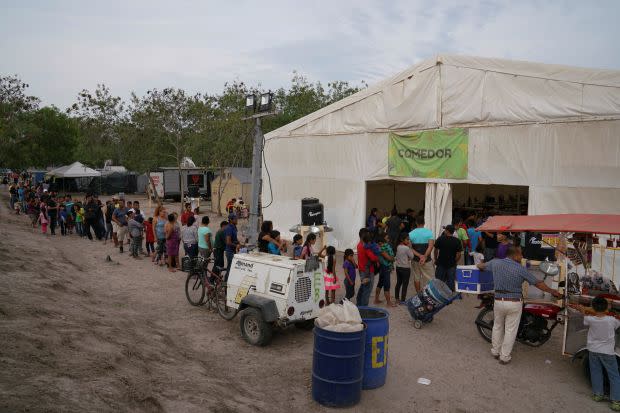Migrant camps on Mexican border are scrambling to avert “mass infection” from coronavirus

Self-isolating isn’t straightforward at the encampment in Matamoros, a Mexican border city home to about 2,500 people living in tents, waiting on US asylum and immigration claims.
There are no confirmed novel coronavirus cases in the camp, but humanitarian organizations are working around the clock to prepare for the “devastating” effect the virus could have if someone does become infected, said Andrea Leiner, director of strategic plans at Matamoros for Global Response Management (GRM), a medical nonprofit. “If Covid does come to our camp, the environment is ripe for mass infection and severe illness,” she said.
The camp’s inhabitants, who mostly traveled from Central America in the infamous “migrant caravans,” now live on a dusty former soccer pitch right next to the Rio Grande. “It looks like a little village from hundreds of years ago, when you didn’t have running water, you didn’t have electricity, you didn’t have the basic amenities we think of as being critical or needed in everyday life,” said Andrea Rudnik, co-founder of Team Brownsville, a nonprofit providing aid from the US side of the border. “It’s extremely dusty. When you get onto the river levees, you get hit with waves of dust and dirt in your face—and that’s constant.”
Mexican media have reported a possible case in the town of Matamoros and a confirmed case in Reynosa, another border town with a large encampment. While US president Donald Trump announced this week he planned to close the border with Mexico, immigration hearings have so far been ongoing. That means migrants living in the camps have been crossing back and forth across the border to attend hearings. It’s possible that after their court appointments people could have brought the virus back from the US, where there are far more confirmed cases than in Mexico, said Maureen Meyer, director for Mexico and Migrant Rights at WOLA, a nonprofit focused on human rights in the Americas. “It could quickly become a real crisis on the border,” she said.
Like the US government, critics have accused the Mexican government of initially taking a laissez-faire approach to the coronavirus crisis in general. President Andres Manuel Lopez Obrador spent last weekend, for example, defiantly hugging and kissing supporters. In Matamoros, authorities at first said the crisis “wasn’t a big deal” and mooted measures like displacing those hit by the virus to a different site, Leiner said. But they have since softened their approach and signed off on humanitarian organizations’ plans, while the head of the local health department has been in constant contact, she said.
But concerns remain that policy could quickly change. “As cases start coming up, one thing we were worried about is if we announce any suspected cases or if we notify the authorities, could that then trigger a border closure? Or violence against the camp? Or someone being detained and never seeing their family again?” Leiner asked. “If we’re further hampered by border closures or supply lines or medical personnel not being able to cross, that makes the fight ahead of us even more difficult.”
Most asylum seekers on the border are young, but their high levels of stress and poor living conditions mean the virus could take a heavy toll on them, said Oscar Misael, an anthropologist at the Colegio de la Frontera Norte, a research institute studying the border area. “We’re talking about a population that is obviously at risk because they were already exposed to conditions of vulnerability—whether social, legal, or in terms of healthcare,” he said.
When Misael surveyed migrants in Reynosa and Matamoros last year, around a third said they had experienced health issues during their journey—many of which were acute respiratory infections. Leiner said most people there are malnourished and nutrient deficient.
GRM has been giving them multivitamins to boost their immune systems—one of three prongs in the strategy to tackle the virus. They have put in place whatever prevention methods are possible, such as moving tents further apart, improving ventilation, and setting up a medical hotline.
People with mild to moderate symptoms will shelter in their tents, while those severely hit will be sent to the local hospital. Once that fills up, GRM will begin treating people in a rudimentary field hospital that can take up to 20 patients. “It’s in the middle of a muddy field where there’s no electricity and no running water,” Leiner said. “We’re clearly not able to provide medical grade oxygen at the quantity where we can ventilate people—that’s just not possible.”
Sign up for the Quartz Daily Brief, our free daily newsletter with the world’s most important and interesting news.
More stories from Quartz:
